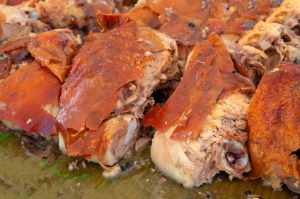Roast Pig, Philippine Style
Dan’s the Man! “Mang Litson”
BY ALEX C. ROMERO
 Dan Manglicmot is a retired engineer, and he has used his creativity with motors and gears to build whole pig rotisseries for his family in Manila and for the Filipino community here in Charlotte. In Manila, Dan’s family and relatives own and reside in a four-story building. On the open rooftop floor is a rotisserie that Dan engineered from old motors and gears. It’s a stainless steel drum that’s been cut in half, with the spit powered by an electric motor. He built a similar rotisserie in Charlotte.
Dan Manglicmot is a retired engineer, and he has used his creativity with motors and gears to build whole pig rotisseries for his family in Manila and for the Filipino community here in Charlotte. In Manila, Dan’s family and relatives own and reside in a four-story building. On the open rooftop floor is a rotisserie that Dan engineered from old motors and gears. It’s a stainless steel drum that’s been cut in half, with the spit powered by an electric motor. He built a similar rotisserie in Charlotte.
Dan’s expertise is roasting a whole pig, known in the Philippines as litson, or lechon (depending on the province, but pronounced roughly the same). His rotisserie skills have served the Filipino community for several years now. His is not a commercial business, but rather a “paki” — a Filipino manner of asking a favor, as in, “Please, Dan, roast a pig for my special occasion?”
In Tagalog, “Mang” means “Mister.” If you were to separate Dan’s surname and replace the last two syllables with the name of his famed roast, Dan Manglicmot becomes Dan Manglitson: “Mister Litson!” Manglitson — it sounds like a brand…
Litson is, of course, not an everyday meal here. When people come from the Philippines to visit expat family or friends here—typically a bienvenida welcome on arrival and despedida for a good-bye party—everyone clamors for the foods they enjoyed growing up with in the Philippines. Food is also the focus of special occasions and at large celebrations — an annual fiesta, or a Catholic event to honor a town’s patron saint perhaps. At many of these events you’ll find lying on a long table, a roast pig — its skin caramel-colored from the heat of the charcoal, with a decorative fruit inserted in the mouth. It is indeed a big deal when a host has a centerpiece of a roast pig.
How Dan Makes Litson
Roasting a pig in the traditional manner is time consuming — from getting the pig (often purchased live) to preparing and cooking it. The traditional method is to stuff the pig with herbs or tamarind leaves, skewer it with a long bamboo pole, and cook it over coals raked in an open pit. The pig cooks for 4 to 6 hours, and the pole is manually turned to roast the pig evenly over the tended heat of the coals. The cooks, usually men, find the occasion to drink their alcohol, smoke, and chat while taking turns with the bamboo.
Everyone likes their litson cooked to perfection, and Dan has high standards to meet: A deep caramel-colored skin color, crispy at delivery, and the aroma of spices at serving are essential. So, of course, is the timing.
 For an 11:00 am pickup, Dan starts at about 6:00 am, preparing a stuffing of chopped lemongrass, green onions, rosemary from his garden, garlic, salt, and black pepper. He packs the belly with the herbs, and then sews it tight with a long curved needle and cotton twine so the cooking juices do not flow out to mar the skin. He uses a small pin to puncture skin blisters and bastes the whole pig with cooking oil, using a brush.
For an 11:00 am pickup, Dan starts at about 6:00 am, preparing a stuffing of chopped lemongrass, green onions, rosemary from his garden, garlic, salt, and black pepper. He packs the belly with the herbs, and then sews it tight with a long curved needle and cotton twine so the cooking juices do not flow out to mar the skin. He uses a small pin to puncture skin blisters and bastes the whole pig with cooking oil, using a brush.
The heat from about two bags of charcoal is regulated as the electric driven rotisserie that can carry a pig of at least forty-five pounds turns, with a meat thermometer to check readiness.
When the pig is cooked, Dan reopens the belly cavity to take out the herb stuffing and removes the rotisserie rod. The roasted pig is then placed on a flat cardboard box lined with plastic to catch the drip and covered lightly to preserve the crispiness and be picked up in time for the party.
Dan “Manglitson” — he helps the community with his engineering know-how, his rotissierie skills, and his desire to cook from head-to-tail a perfect tasty, caramel-colored Litson.
About Litson (also known as Lechon)
Lechon is believed to have been derived from the Spanish word leche, or milk. The dish originally was made with young suckling pigs — that is, pigs that were still nursing milk from their mothers. At some point, cooks started using bigger pigs. Now, lechon simply refers to a spit-roasted pig slowly rotisseried over open coals. Although it acquired the Spanish name, Philippine lechon likely has pre-Hispanic origins, as pigs were domesticated throughout Asia well before the Spanish arrived. Léchon (as it’s spelled in Spanish) is popular in several regions of the world, most specifically in Spain and former Spanish colonial possessions. In addition to the Philippines, versions of lechón are popular in Spain, Cuba, Puerto Rico, the Dominican Republic, and other Spanish-speaking nations in Latin America. Philippine lechon is especially known for its skin — evenly smooth and shiny, and crispy for up to several hours.
SHARE THIS PAGE
